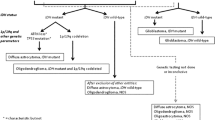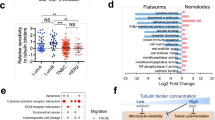Abstract
Introduction
The prognosis for leptomeningeal metastasis (LM) remains extremely poor regardless of intrathecal chemotherapy with various drugs, and thus, new treatments are necessary. Butyrate is an endogenous 4-carbon saturated fatty acid, has been investigated as an anti-tumor agent because of its multiple suppressive effects on several tumors. In this study, we investigated the cellular basis of sodium butyrate (SB), a sodium salt compound of butyrate, in vitro and evaluated the clinical potential of intrathecal SB administration for LM in vivo.
Methods
We examined SB’s effects on Walker 256 rat mammary tumor cells with regard to cytotoxicity, cell morphology, colony formation, migration, and invasion. We also examined SB’s neurotoxicity for primary neurons and primary astrocytes. We finally evaluated the potency of continuous intrathecal SB administration in rats with intrathecally transplanted breast tumors as an LM model.
Results
Physiological SB concentrations (2–4 mM) induced growth suppression, morphological changes, and inhibition of migration and invasion, but did not exhibit neurotoxic effects on primary neurons and astrocytes. Continuous intrathecal SB administration in a rat LM model significantly increased survival periods with little neurotoxicity.
Conclusions
Continuous intrathecal SB administration significantly improved prognoses in a rat LM model, which suggests that SB is a promising therapy for LM.





Similar content being viewed by others
Abbreviations
- Ara-C:
-
Cytosine arabinoside
- DAPI:
-
4′,6-Diamidino-2-phenylindole
- DMEM:
-
Dulbecco modified essential medium
- FBS:
-
Fetal bovine serum
- MEM:
-
Minimum essential medium
- MTX:
-
Methotrexate
- PBS:
-
Phosphate buffer saline
References
Taillibert S, Laigle-Donadey F, Chodkiewicz C, Sanson M, Hoang-Xuan K, Delattre J-Y (2005) Leptomeningeal metastases from solid malignancy: a review. J Neurooncol 75(1):85–99. https://doi.org/10.1007/s11060-004-8101-x
Le Rhun E, Taillibert S, Chamberlain MC (2017) Neoplastic meningitis due to lung, breast, and melanoma metastases. Cancer Control 24(1):22–32
Taillibert S, Hildebrand J (2006) Treatment of central nervous system metastases: parenchymal, epidural, and leptomeningeal. Curr Opin Oncol 18(6):637–643. https://doi.org/10.1097/01.cco.0000245323.19411.d7
Nakagawa H, Murasawa A, Kubo S et al (1992) Diagnosis and treatment of patients with meningeal carcinomatosis. J Neurooncol 13(1):81–89
Grewal J, Saria MG, Kesari S (2012) Novel approaches to treating leptomeningeal metastases. J Neurooncol 106(2):225–234. https://doi.org/10.1007/s11060-011-0686-2
Groves MD (2010) New strategies in the management of leptomeningeal metastases. Arch Neurol 67(3):305–312. https://doi.org/10.1001/archneurol.2010.18
Roth P, Weller M (2015) Management of neoplastic meningitis. Chin Clin Oncol 4(2):26. https://doi.org/10.3978/j.issn.2304-3865.2015.05.02
Fields MM (2013) How to recognize and treat neoplastic meningitis. J Adv Pract Oncol 4(3):155–160
Blaney SM, Balis FM, Berg S et al (2005) Intrathecal mafosfamide: a preclinical pharmacology and phase I trial. J Clin Oncol 23(7):1555–1563. https://doi.org/10.1200/JCO.2005.06.053
Blaney SM, Heideman R, Berg S et al (2003) Phase I clinical trial of intrathecal topotecan in patients with neoplastic meningitis. J Clin Oncol 21(1):143–147. https://doi.org/10.1200/JCO.2003.04.053
Sampson JH, Archer GE, Villavicencio AT et al (1999) Treatment of neoplastic meningitis with intrathecal temozolomide. Clin Cancer Res 5(5):1183–1188
Nakagawa H, Miyahara E, Suzuki T, Wada K, Tamura M, Fukushima Y (2005) Continuous intrathecal administration of 5-fluoro-2′-deoxyuridine for the treatment of neoplastic meningitis. Neurosurgery 57(2):266–280
Nakagawa H, Yoshioka K, Miyahara E, Fukushima Y, Tamura M, Itoh K (2005) Intrathecal administration of Y-27632, a specific rho-associated kinase inhibitor, for rat neoplastic meningitis. Mol Cancer Res 3(8):425–433. https://doi.org/10.1158/1541-7786.MCR-05-0002
Pryde SE, Duncan SH, Hold GL, Stewart CS, Flint HJ (2002) The microbiology of butyrate formation in the human colon. FEMS Microbiol Lett 217(2):133–139
Scharlau D, Borowicki A, Habermann N et al (2009) Mechanisms of primary cancer prevention by butyrate and other products formed during gut flora-mediated fermentation of dietary fibre. Mutat Res 682(1):39–53. https://doi.org/10.1016/j.mrrev.2009.04.001
Encarnação JC, Abrantes AM, Pires AS, Botelho MF (2015) Revisit dietary fiber on colorectal cancer: butyrate and its role on prevention and treatment. Cancer Metastasis Rev 34(3):465–478. https://doi.org/10.1007/s10555-015-9578-9
Hamer HM, Jonkers D, Venema K, Vanhoutvin S, Troost FJ, Brummer R-J (2007) Review article: the role of butyrate on colonic function. Aliment Pharmacol Ther 27(2):104–119. https://doi.org/10.1111/j.1365-2036.2007.03562.x
Davie JR (2003) Inhibition of histone deacetylase activity by butyrate. J Nutr 133(7 Suppl):2485S–2493S
Damaskos C, Valsami S, Kontos M et al (2017) Histone deacetylase inhibitors: an attractive therapeutic strategy against breast cancer. Anticancer Res 37(1):35–46. https://doi.org/10.21873/anticanres.11286
Zhang J, Yi M, Zha L et al (2016) Sodium butyrate induces endoplasmic reticulum stress and autophagy in colorectal cells: implications for apoptosis. PLoS ONE 11(1):e0147218. https://doi.org/10.1371/journal.pone.0147218
Hara I, Miyake H, Hara S, Arakawa S, Kamidono S (2000) Sodium butyrate induces apoptosis in human renal cell carcinoma cells and synergistically enhances their sensitivity to anti-Fas-mediated cytotoxicity. Int J Oncol 17(6):1213–1218
Katzenmaier E-M, André S, Kopitz J, Gabius H-J (2014) Impact of sodium butyrate on the network of adhesion/growth-regulatory galectins in human colon cancer in vitro. Anticancer Res 34(10):5429–5438
Farrow B, Rychahou P, O’Connor KL, Evers BM (2003) Butyrate inhibits pancreatic cancer invasion. J Gastrointest Surg 7(7):864–870
Demary K, Wong L, Spanjaard RA (2001) Effects of retinoic acid and sodium butyrate on gene expression, histone acetylation and inhibition of proliferation of melanoma cells. Cancer Lett 163(1):103–107
Engelhard HH, Duncan HA, Kim S, Criswell PS, Van Eldik L (2001) Therapeutic effects of sodium butyrate on glioma cells in vitro and in the rat C6 glioma model. Neurosurgery 48(3):616–625
Conway RM, Madigan MC, Billson FA, Penfold PL (1998) Vincristine- and cisplatin-induced apoptosis in human retinoblastoma. Potentiation by sodium butyrate. Eur J Cancer 34(11):1741–1748
Lauricella M, Calvaruso G, Giuliano M et al (2000) Synergistic cytotoxic interactions between sodium butyrate, MG132 and camptothecin in human retinoblastoma Y79 cells. Tumour Biol 21(6):337–348. doi:30139
Sankaranarayanan K, von Duyn A, Loos MJ, Meschini R, Natarajan AT (2000) Effects of sodium butyrate on X-ray and bleomycin-induced chromosome aberrations in human peripheral blood lymphocytes. Genet Res 56(2–3):267–276
Stoilov L, Darroudi F, Meschini R, van der Schans G, Mullenders LH, Natarajan AT (2000) Inhibition of repair of X-ray-induced DNA double-strand breaks in human lymphocytes exposed to sodium butyrate. Int J Radiat Biol 76(11):1485–1491
Vernia P, Fracasso PL, Casale V et al (2000) Topical butyrate for acute radiation proctitis: randomised, crossover trial. Lancet 356(9237):1232–1235
Maggio A, Magli A, Rancati T et al (2014) Daily sodium butyrate enema for the prevention of radiation proctitis in prostate cancer patients undergoing radical radiation therapy: results of a multicenter randomized placebo-controlled dose-finding phase 2 study. Int J Radiat Oncol Biol Phys 89(3):518–524. https://doi.org/10.1016/j.ijrobp.2014.03.018
Krokowicz L, Stojcev Z, Kaczmarek BF et al (2014) Microencapsulated sodium butyrate administered to patients with diverticulosis decreases incidence of diverticulitis—a prospective randomized study. Int J Colorectal Dis 29(3):387–393. https://doi.org/10.1007/s00384-013-1807-5
Raqib R, Sarker P, Mily A et al (2012) Efficacy of sodium butyrate adjunct therapy in shigellosis: a randomized, double-blind, placebo-controlled clinical trial. BMC Infect Dis 12(1):111. https://doi.org/10.1186/1471-2334-12-111
Ziemka-Nalecz M, Jaworska J, Sypecka J, Polowy R, Filipkowski RK, Zalewska T (2016) Sodium butyrate, a histone deacetylase inhibitor, exhibits neuroprotective/neurogenic effects in a rat model of neonatal hypoxia-ischemia. Mol Neurobiol. https://doi.org/10.1007/s12035-016-0049-2
Jaworska J, Ziemka-Nalecz M, Sypecka J, Zalewska T (2017) The potential neuroprotective role of a histone deacetylase inhibitor, sodium butyrate, after neonatal hypoxia-ischemia. J Neuroinflammation 14(1):34. https://doi.org/10.1186/s12974-017-0807-8
Li H, Sun J, Wang F et al (2016) Sodium butyrate exerts neuroprotective effects by restoring the blood-brain barrier in traumatic brain injury mice. Brain Res 1642:70–78. https://doi.org/10.1016/j.brainres.2016.03.031
Asou H, Hirano S, Kohsaka S (1989) Changes in ganglioside composition and morphological features during the development of cultured astrocytes from rat brain. Neurosci Res 6(4):369–375
Donohoe DR, Collins LB, Wali A, Bigler R, Sun W, Bultman SJ (2012) The Warburg effect dictates the mechanism of butyrate-mediated histone acetylation and cell proliferation. Mol Cell 48(4):612–626. https://doi.org/10.1016/j.molcel.2012.08.033
Vander Heiden MG, Cantley LC, Thompson CB (2009) Understanding the Warburg effect: the metabolic requirements of cell proliferation. Science 324(5930):1029–1033. https://doi.org/10.1126/science.1160809
Author information
Authors and Affiliations
Corresponding author
Electronic supplementary material
Below is the link to the electronic supplementary material.

Figure S1. Surgical osmotic pump implantation into the medullary cavity
. a. The osmotic mini-pump. Bar = 1 cm. b. Schematic of osmotic mini-pump implantation (JPG 1041 KB)

Figure S2. Effect of MTX treatment on neuronal cells and astrocyte
. a. Neuron viability in the presence of MTX. We treated primary isolated neurons with various MTX concentrations and observed cell viability. b. Astrocyte viability in the presence of MTX. We treated primary isolated astrocytes with various MTX concentrations and observed cell viability. *: P < 0.01; abbreviations: MTX, methotrexate (JPG 414 KB)

Figure S3. Histological confirmation of SB-induced brain damage
. An SB-treated rat brain was sectioned and stained with hematoxylin and eosin or with the Klüver-Barrera method. No obviously damaged regions were observed. Bar = 50 µm. Abbreviation: SB, sodium butyrate (JPG 1712 KB)
Rights and permissions
About this article
Cite this article
Nakagawa, H., Yui, Y., Sasagawa, S. et al. Evidence for intrathecal sodium butyrate as a novel option for leptomeningeal metastasis. J Neurooncol 139, 43–50 (2018). https://doi.org/10.1007/s11060-018-2852-2
Received:
Accepted:
Published:
Issue Date:
DOI: https://doi.org/10.1007/s11060-018-2852-2




